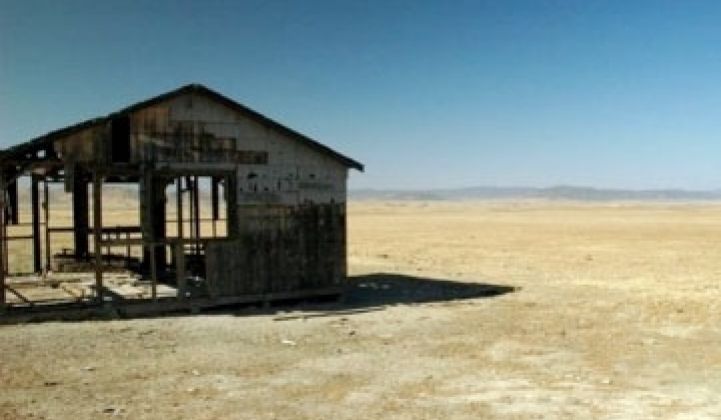A huge step has been taken towards building one of the globe's largest photovoltaic installations.
The Environmental Impact Report (EIR) for the 250-megawatt California Valley Solar Ranch has been issued and is now in the public comment phase. San Luis Obispo County issued their draft EIR, becoming one of the the first counties in the U.S. to prepare such a document for a large-scale solar facility. In June, Los Angeles County published its DEIR for the 230 megawatt Antelope Valley Solar Ranch originally being developed by NextLight and now in the hands of First Solar.
"The joys of vertical integration"
You'd think that being a solar manufacturer would be mostly about silicon and wafers and cells and modules. But if you're vertically integrated like SunPower and also designing and constructing the photovoltaic power site, then you're building power plants, not just solar panels. And your areas of expertise have to span not just the physics of PV, but the intricacies of land use, the biology of endangered species, and a suite of other concerns.
As SunPower VP Julie Blunden said, "This is the power industry. We're putting in a power station, which two years ago -- the concept did not exist. We are behaving like any power plant developer, trying to provide a thoughtful design and be a good neighbor."
The draft EIR entering the public comment phase marks the end of a very intensive two year process for SunPower and the stakeholders in this project -- from site neighbors to utilities to environmentalists. Blunden added, "The public discussion is after two years of hard work by SunPower, making adjustments to make the project as low impact and as light on the land as possible."
The 250 megawatt project would include solar arrays covering nearly 1,900 acres, an electric substation, operations and maintenance facilities, public viewing areas, and an approximately 2.8‐mile 230-kV generation tie-line.
Endangered Species, Water Use and Human Neighbors
The site of this solar installation in San Luis Obispo county, The Carrizo Plains, is home to 13 different species listed as endangered either by the state or federal government. The impact of the project on each of those species, from the San Joaquin Kit Fox to the Giant Kangaroo Rat to the California condor, had to be assessed by biologists in separate studies. Rare plants and grasses were also part of the assessment. Fencing design had to accomodate animal movement and "small animal penetration."
All together, 60 biologists were involved in 30 biological surveys.
Water usage both in construction and in operation had to be considered and dealt with. The initial T20 tracker design involved concrete pedestals but the concrete pedestals were replaced with ground penetrating rods and water usage was reduced by 20 percent. More efficient panel washing was also part of the water reduction.
The T20 trackers were also changed to T0 trackers to reduce the visual impact of the project. Eliminating the trackers also reduced the impact on widlife.
There are only about 75 residences in the area, but steps were nonetheless taken to minimize traffic and noise. SunPower is involved in employee transportation to the site, as well as temporary housing for workers, since the California Valley Hilton has not been completed.
Note that although there are solar panels covering 1,900 acres, the project site totals about 4,300 acres. The non-solar areas will remain uncovered as a permanent conservation measure.
The land itself and the importance of panel efficiency
We've seen the uproar from environmentalists and politicians about building solar plants on pristine desert land.
The California Valley site is defined as "disturbed agricultural land" and according to SunPower's Greg Blue, a variety of agencies including the NRDC and RETI have pointed to disturbed ag land as the premier site for solar.
Blunden said, "This is a fantastic site and one of the best uses of the land...it's flat with low fog, fantastic sun, and has transmission access with just a little upgrading."
"People talk about central station project development as if land was limitless," said Blunden.
And that brings up another under-appreciated value to SunPower's industry-leading solar cell efficiency. Because the high-efficiency panels maximize megawatts per square meter, a lot less land is used, entailing a lot less permitting, structures, balance of system, cabling, trenching, roads, shipping, fencing, security, foundations, construction management and O&M.
Land is not limitless -- and efficiency matters.
SunPower estimates that 14-percent-efficient panels would produce 186 megawatts, and 11-percent-efficient panels (who would they have in mind there?) would produce 146 megawatts on the same amount of land.
So what happens next?
The issuance of today's draft EIR marks the beginning of a 45-day comment period. Comments will be taken on the draft EIR, followed by another 30 or 40 days for responses to those comments. Once the responses are provided, there's another 60 days for revisions to the draft which will yield the final EIR.
The final EIR then goes to the SLO planning commission. It could be approved at that point or could be appealed. If it gets appealed, it goes to the board of supervisors for the final EIR certification and then it's back to the county for building permits. That process can take until February of 2011. If all goes as per plan, trucks could be rolling in June 2011.
Greg Blue, SunPower's Director of Market Development for Utility and Power Plants, said, "We are very happy and very excited to be in the public phase of the process. We've been working at this for over two years. This is very a big deal for the county. San Luis Obispo County has been a leader in renewable energy."
It's also a big deal for the U.S. solar industry.



